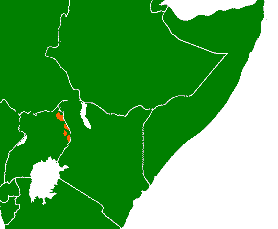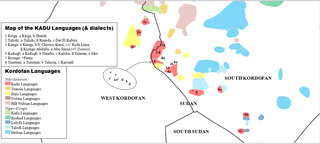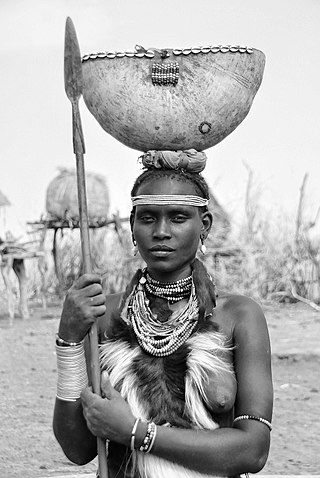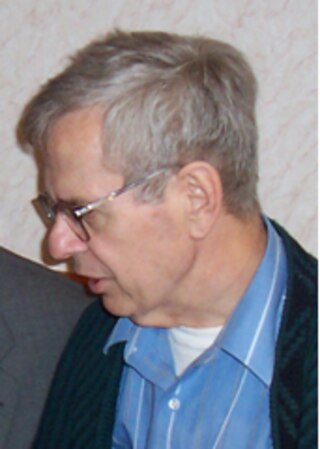
The Afroasiatic languages, also known as Hamito-Semitic or Semito-Hamitic, are a language family of about 400 languages spoken predominantly in West Asia, North Africa, the Horn of Africa, and parts of the Sahara and Sahel. Over 500 million people are native speakers of an Afroasiatic language, constituting the fourth-largest language family after Indo-European, Sino-Tibetan, and Niger–Congo. Most linguists divide the family into six branches: Berber, Chadic, Cushitic, Egyptian, Semitic, and Omotic. The vast majority of Afroasiatic languages are considered indigenous to the African continent, including all those not belonging to the Semitic branch.

The Chadic languages form a branch of the Afroasiatic language family. They are spoken in parts of the Sahel. They include 150 languages spoken across northern Nigeria, southern Niger, southern Chad, the Central African Republic, and northern Cameroon. By far the most widely spoken Chadic language is Hausa, a lingua franca of much of inland Eastern West Africa, particularly Niger and the northern half of Nigeria.

The Cushitic languages are a branch of the Afroasiatic language family. They are spoken primarily in the Horn of Africa, with minorities speaking Cushitic languages to the north in Egypt and Sudan, and to the south in Kenya and Tanzania. As of 2012, the Cushitic languages with over one million speakers were Oromo, Somali, Beja, Afar, Hadiyya, Kambaata, and Sidama.

The Nilo-Saharan languages are a proposed family of African languages spoken by somewhere around 70 million speakers, mainly in the upper parts of the Chari and Nile rivers, including historic Nubia, north of where the two tributaries of the Nile meet. The languages extend through 17 nations in the northern half of Africa: from Algeria to Benin in the west; from Libya to the Democratic Republic of the Congo in the centre; and from Egypt to Tanzania in the east.

The Omotic languages are a group of languages spoken in southwestern Ethiopia, in the Omo River region. The Geʽez script is used to write some of the Omotic languages, the Latin script for some others. They are fairly agglutinative and have complex tonal systems. The languages have around 6.2 million speakers. The group is generally classified as belonging to the Afroasiatic language family, but this is disputed by some.

The Kuliak languages, also called the Rub languages, are a group of languages spoken by small relict communities in the mountainous Karamoja region of northeastern Uganda.

In most classifications, the Eastern Sudanic languages are a group of nine families of languages that may constitute a branch of the Nilo-Saharan language family. Eastern Sudanic languages are spoken from southern Egypt to northern Tanzania.
Lowland East Cushitic is a group of roughly two dozen diverse languages of the Cushitic branch of the Afro-Asiatic family. Its largest representatives are Oromo and Somali.
The South Cushitic or Rift languages of Tanzania are a branch of the Cushitic languages. The most numerous is Iraqw, with half a million speakers. Scholars believe that these languages were spoken by Southern Cushitic agro-pastoralists from Ethiopia, who began migrating southward into the Great Rift Valley in the third millennium BC.

The Kadu languages, also known as Kadugli–Krongo or Tumtum, are a small language family of the Kordofanian geographic grouping, once included in Niger–Congo. However, since Thilo Schadeberg (1981), Kadu is widely seen as Nilo-Saharan. Evidence for a Niger-Congo affiliation is rejected, and a Nilo-Saharan relationship is controversial. A conservative classification would treat the Kadu languages as an independent family.
The Surmic languages are a branch of the Eastern Sudanic language family.

The languages of Ethiopia include the official languages of Ethiopia, its national and regional languages, and a large number of minority languages, as well as foreign languages.

The Daasanach are an ethnic group inhabiting parts of Ethiopia, Kenya, and South Sudan. Their main homeland is in the Debub Omo Zone of the Southern Nations, Nationalities, and People's Region, adjacent to Lake Turkana. According to the 2007 national census, they number 48,067 people, of whom 1,481 are urban dwellers.
Mursi is a Southeast Surmic language spoken by the Mursi people who live in the South Omo Zone on the eastern side of the lower Omo valley in southwest Ethiopia. The language is similar to Suri, another Southeast Surmic language spoken to the west of the Mursi language area. It is spoken by approximately 7,400 people.
Harold Crane Fleming was an American anthropologist and historical linguist specializing in the cultures and languages of the Horn of Africa. As an adherent of the Four Field School of American anthropology, he stressed the integration of physical anthropology, linguistics, archaeology, and cultural anthropology in solving anthropological problems.

Marvin Lionel Bender was an American linguist.

The Majang language is spoken by the Majangir people of Ethiopia. Although it is a member of the Surmic language cluster, it is the most isolated one in the group. A language survey has shown that dialect variation from north to south is minor and does not seriously impede communication. The 2007 Ethiopian Census lists 6,433 speakers for Majang (Messengo), but also reports that the ethnic group consists of 32,822 individuals. According to the census, almost no speakers can be found in Mezhenger Zone of Gambela Region; a total of eleven speakers are listed for the zone, but almost 10,000 ethnic Mejenger or Messengo people.

Karo is a South Omotic language spoken in the Debub (South) Omo Zone of the Southern Nations, Nationalities, and People's Region in Ethiopia. Karo is described as being closely related to its neighbor, Hamer-Banna, with a lexical similarity of 81%, and is considered a dialect of Hamer by Blench (2006), but as a separate language belonging to the Hamer-Karo subfamily in Glottolog. The Karo people, who live close to the lower Omo River, use colorful bodywork, complex headdresses and body scars to express beauty and importance within the community. 2,400 speakers are using the Karo language.
Hozo is an Afroasiatic language spoken mostly in the Kondala woreda of Mirab Welega Zone by peoples generically known as "Mao". There are smaller groups of Hozo speakers in Mana Sibu woreda. The term Hozo is usually understood by the Mao to refer to a clan. Hozo speakers prefer to call themselves Amo. Hozo and Seze are sometimes called Begi Mao. Hozo is spoken by roughly 3,000 people in Ethiopia. Hozo is also a clan in the Begi area. The Hozo language is also known as Begi-Mao and Mao of Begi. Its classification is Afro-Asiatic, Omotic, and Mao. The word Mao is Omotic and means ‘man; people’, occurring as [ma:ɪ] in Seze and as [mɔ:] in Hozo. Mao is frequently used as an ethnic term. There is a kind of Mao identity across language differences in Ethiopia. While it is generally accepted today that Omotic is one of the primary branches of the Afro-Asiatic family, the position of the four languages Hozo, Seze, Ganza and Northern Mao is still being discussed. The Mao languages are the least documented within Omotic, and Omotic itself is the least documented of the Afroasiatic groups.

The Kwegu are an ethnic group that lives on the western banks of the Omo River in the newly formed South Ethiopia Region. Some members of the Kwegu also live on the eastern banks of the river among the Mursi. Previously they were hunter-gatherers, but today they are engaged in a mixed economy of hunting, farming, beekeeping, and fishing.













